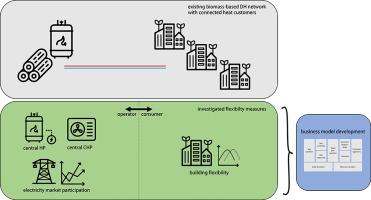Profitability of biomass-based district heating considering different technology combinations and building flexibility
Abstract
District heating can help to integrate renewable generation within the electricity domain and thus reach climate and energy goals by providing flexibility services and stabilizing the electricity grid. To determine the economic viability of such flexibility services, this work presents a profitability analysis of a central heat pump and/or combined heat and power unit within a biomass-based district heating network, conducted with a mixed-integer linear optimization model. Subsequent business model development for district heating utilities is conducted using the Business Model Canvas and the Odyssey 3.14 approach. Business model development and innovation are crucial to make use of the existing flexibility potential. The results show that the district heating utility's profitability as annual net profit increases in comparison with the status quo of biomass heat-only boilers when an additional heat pump is installed that can operate both in spot and balancing markets. Furthermore, all use cases including governmental support (for the heat pump, the combined heat and power unit or for both) prove to be economically favorable. The innovated business models indicate additional value for increased customer segments, thus enabling additional revenue streams for the district heating utility which can therefore promote the provision of flexibility in district heating.


 求助内容:
求助内容: 应助结果提醒方式:
应助结果提醒方式:


